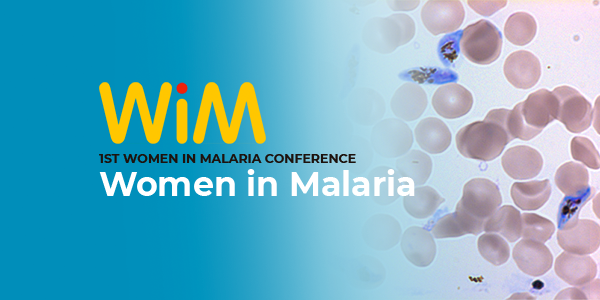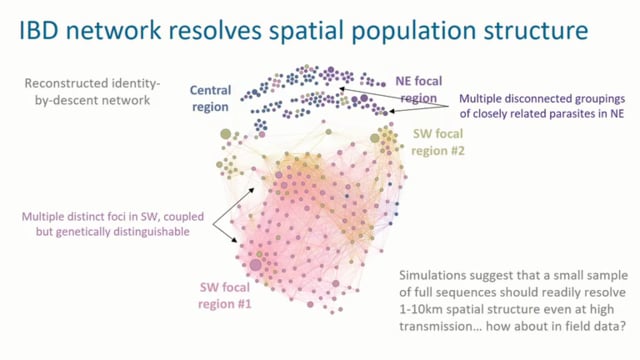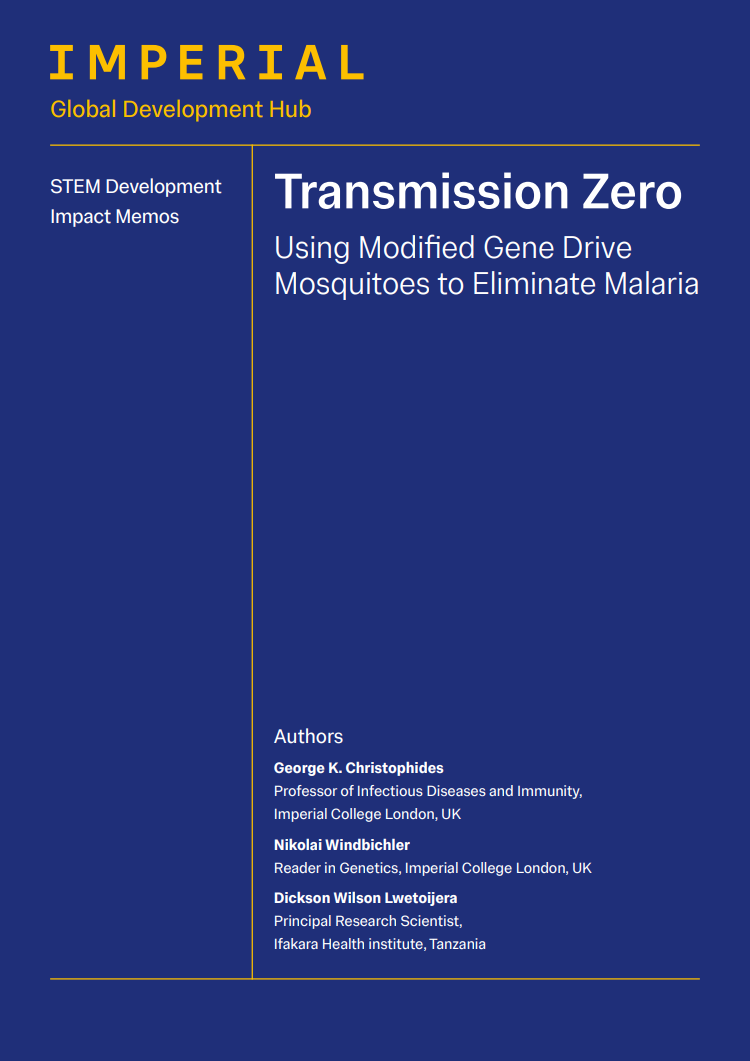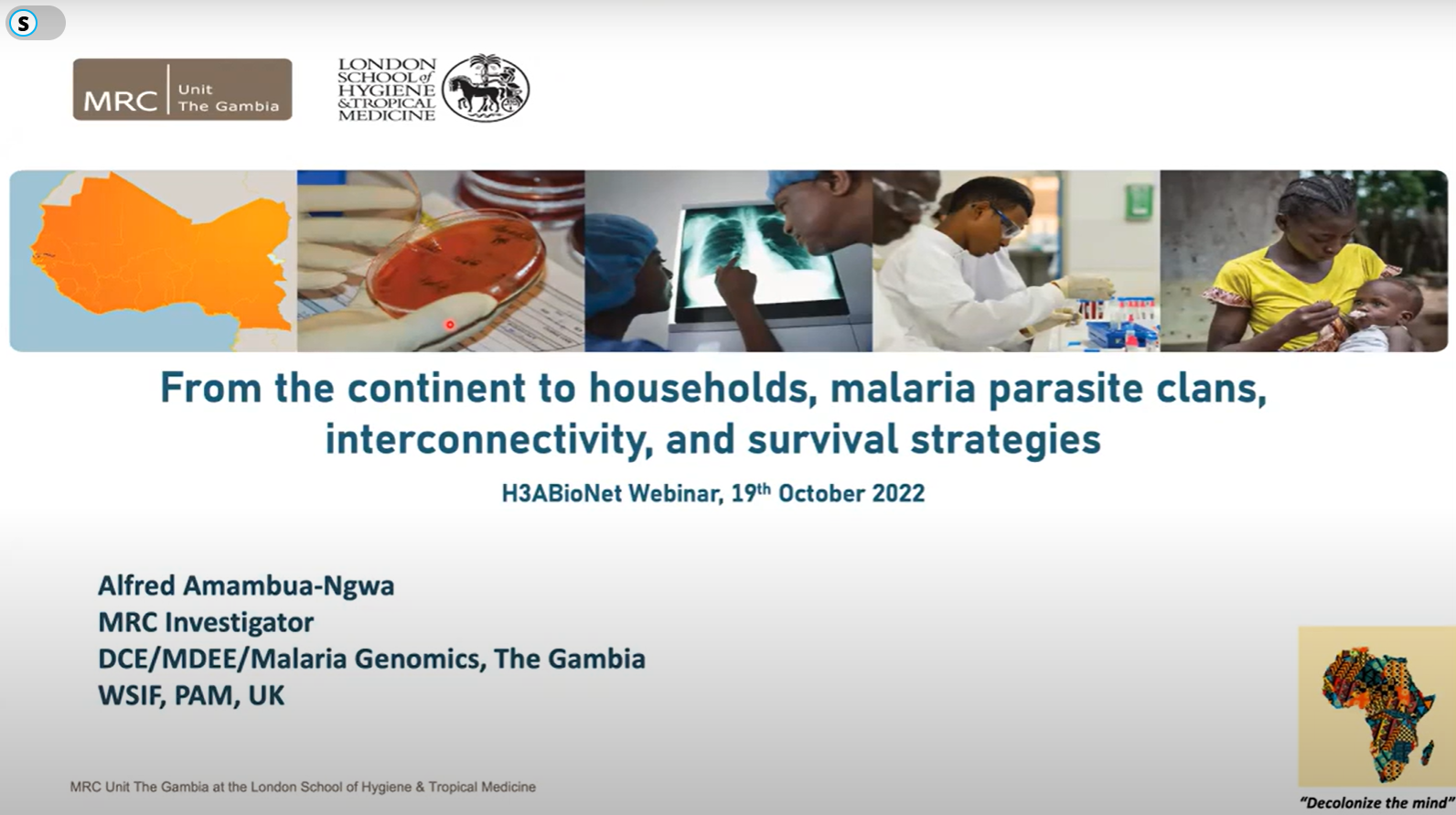1st Women in Malaria (WiM) Virtual Conference – 2021: Day 2
Tuesday, 23rd March 2021
Published: 22/03/2021
This report is brought to you by the MESA Correspondents Sushma Ambekar, Christine Markwalter, Rosheen Mthawanji, and Diane Leslie Nkahe. Senior editorial support has been facilitated by Joanne Power, Elena Gómez Díaz and Sarah Reece.
THEMES: THEMES: Basic Science | Epidemiology | Health Systems
MESA Correspondents bring you cutting-edge coverage from the 1st Women in Malaria Conference
Day 2: Tuesday, 23rd March 2021
Session 5 – Transmission biology
Virginia Howick (University of Glasgow, UK) and Anne Vardo-Zalik (Penn State York, USA) chaired this session which focussed on malaria transmission biology, a known bottleneck in the parasite life cycle. Speakers presented their data on the study of host and parasite genetic and ecological factors that influence transmission and how these factors can be used in designing novel antimalarial therapeutics.
Claire Sayers (Umeå University, Sweden) presented her recent findings using sex-specific genetic screens aimed at identifying Plasmodium fertility genes with sex-specific roles. Obtaining such data will allow the malaria community to better grasp the underlying mechanisms of the transmission stage itself. Transfecting barcoded PlasmoGEM vectors into male-only and female-only P. berghei parasites, followed by transcriptomic analysis provided the research group with hundreds of genes with sex-specific roles. They observed enrichment of 74% male and 16% female-specific fertility genes in their respective clusters. To better understand male fertility, Sayers and colleagues designed a density gradient-based assay to separate male gametes after exflagellation in order to understand gene expression profiles before, during and after exflagellation. This yielded a repertoire of previously-identified genes associated with pre-motility (AP2-G), motility (DLC1) and post-motility (UIS4) along with multiple novel, unannotated gene candidates. Looking deeper into sexual male stages, they tried to identify new components of the flagellum, which is formed exclusively during the formation of male gametes in the mosquito midgut. Their results contained known and unknown flagellum components, including 12 essential male fertility genes that displayed non-motile phenotype in mutants. Sayers concluded by highlighting that these essential male fertility genes could serve as potential transmission-blocking targets.
Juliana Cudini (Wellcome Sanger Institute, UK) and her team set out to explore the sexual development of the malaria parasite by trying to find evidence of predetermined factors for male and female gametocytes. They followed 62,000 P. falciparum NF54 and 7G8 parasites as they exited the asexual stages into gametocyte development and carried out single-cell RNA sequencing at 8 different time points. They focused on two main branch points of the process: cyclical departure and sexual differentiation, which indeed showed varying gene expression patterns. Cudini pointed out that cyclical departure was marked by an increased expression of genes such as AP2-G, ETRAMP4, GEXP02 and G27/25 which drop rapidly during sexual differentiation. During sexual differentiation, however, genes such as Pfs16 showed increased expression. Looking further into the transcriptomic data of late male and female gametocyte markers, a distinct set of sex-specific genes were identified. However, early male and female stages exhibited the same transcriptomic profile, indicating that gene expression during early sexual commitment in immature gametocytogenesis is identical prior to male and female differentiation. This work allowed high-resolution single-cell transcriptomic analysis of sexual differentiation in the Plasmodium parasite, thus capturing the heterogeneity of the cells can be explored further at the Malaria Cell Atlas website.
Megan Greischar (Cornell University, USA) presented her research on how parasites balance the trade-off between making asexual stages versus producing gametocytes for transmission. Greischar attempted to answer this with a data-driven model. While within-host ecology selects for parasite proliferation to gain competitive advantage against other strains, ecology outside the host favours transmission investment. At this scale, the parasite’s investment could be affected by infected hosts who recover, waxing and waning of vectors, and finally, the growth and decline of epidemics. The fitness strategy included transmission investment variation according to age of host infection. Simulated malaria dynamics show that parasites that invest in transmission stages take longer to reach the peak of infectiousness when compared to parasites that favour proliferation. While vector dynamics, such as a shrinking mosquito larval population, forced the parasites to select for aggressive proliferation at expenses of lower transmission rate, a growing mosquito population resulted in higher transmission. Lastly, Greischar talked about epidemics altering the mean age of infection. In the early stages of an epidemic, transmission stages are lower as parasites are trying to proliferate rapidly. In this case, within-host ecology (co-infection) is favored. In conclusion, the ecology outside the host imposes selection on transmission investment, and that is where humans have the most leverage against the parasite.
Melissa Alexis Iacovidou (University of Warwick, UK) discussed efforts to study mosquitoes to quantify the potential of malaria transmission in an age-dependent manner. Her group has checked if mortality rates change due to multiple insecticide exposure and its impact on mosquitoes’ vectorial capacity. They also investigated vectorial capacity age-dependency. Investigating this hypothesis involved mosquito-biting experiments in which volunteers placed their feet underneath long-lasting insecticidal nets (LLINs) and nets without insecticides. 200 mosquitoes were tested every 4 days. Age-dependent mortality, survival function, and relationship between survival and mortality function were used to assess the life trait parameters. Results showed that the higher the extrinsic incubation period (EIP), the greater the age of the mosquito, and the lower the number of bites it takes. The probability of the number of bites is lower at a younger age. Age dependency was also lower in treatment compared to control. They concluded that despite mosquitoes being insecticide resistant, the vectorial capacity is reduced in higher age mosquitoes. Therefore, anti-vectorial interventions have been underestimated when age is considered. In the future, this group will explore different distributions for the EIP, including realistic mosquito bite rate to match mosquito behaviour, constructing a disease model to see the effect of age-dependency in mosquitoes on transmission, and matching human malaria cases to disease models to evaluate control programmes.
Elena A Levashina (Max Planck Institute for Infection Biology, Germany) spoke about humanizing the mosquito immune system. The Plasmodium circumsporozoite protein (CSP) is the major surface protein of sporozoites and the CSP repeat region provides the highly immunogenic basis of the vaccine: RTS,S/ASO1. In this study, natural human monoclonal anti-CSP antibodies (mAbs) were studied with a traversal inhibition assay of P. falciparum. The team generated a new transgenic mosquito line, lipophorin:125 (Lp:125), and observed that expression of mAb125 reduced prevalence of salivary gland infection and limited the sporozoite loads. The number of oocysts was similar between wild-type and mutant, but sporozoite numbers were very low in mutants at 14 dpi and 18 dpi, thus, they focused on oocyst development. The majority of the parasites in the mutant mosquito were not sporulating due to membrane retraction and thus showed sporogenic defects. When oocyst numbers were low, the proportion of sporulating oocysts was 0, and as oocyst numbers increased, the mAb was not sufficient to stop sporulation. Similar results were observed with the number of mean salivary gland sporozoites for low and high number of oocysts. The immune factor, thioester-containing protein 1 (TEP1) was found to limit P. berghei development by binding and killing ookinetes. This group will further study the titration effect of mAb125 on P. falciparum sporogony and in conditions of low oocyst density found in salivary glands of mosquitoes expressing scFv-125.
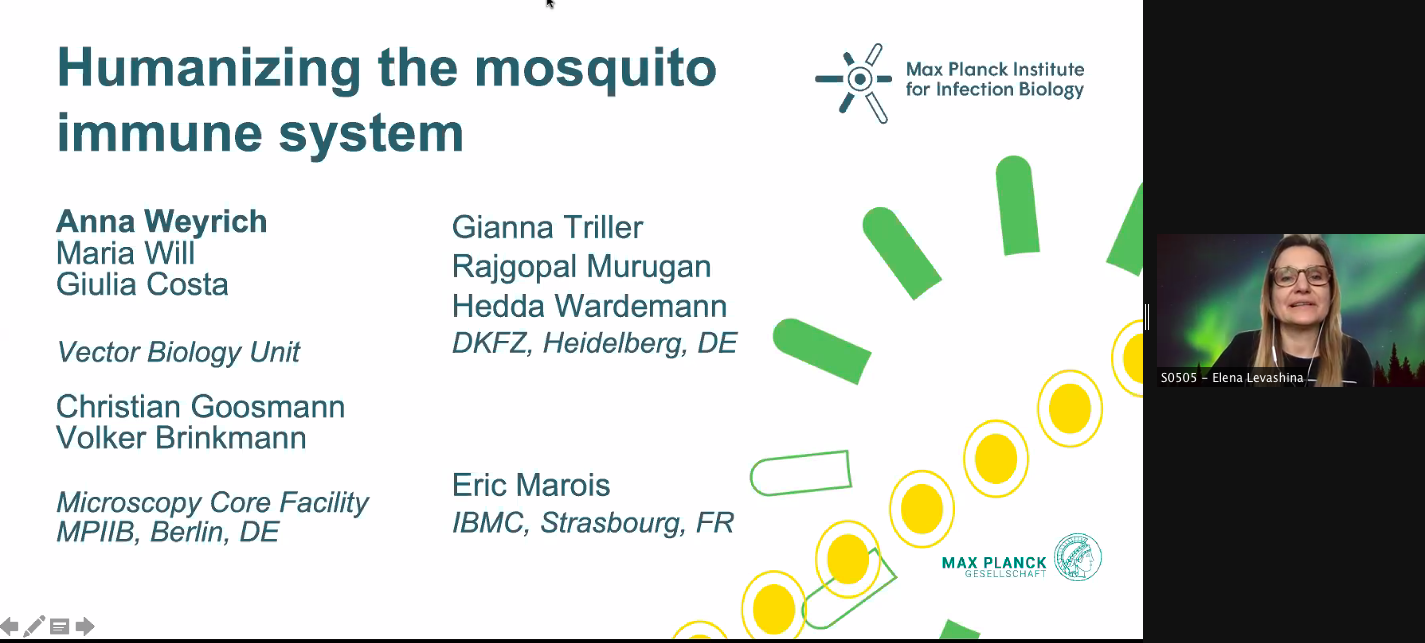
Session 6 – Social and economic aspects of malaria
Angela Devine (Menzies School of Health Research, Australia) and Corine Karema (African Leaders Malaria Alliance – ALMA and Swiss Tropical and Public Health Institute, Switzerland) welcomed participants to the session addressing social and economic aspects of malaria.
Ellie Sherrard Smith (Imperial College London, UK) shared her work on the global challenges of controlling COVID-19 and malaria. She pointed out that even though most studies focussed on the individual, local or regional scale, we all fall on the planetary scale and also that most publications now look at this holistic way of solving problems. As an example of this, she talked about integrated vector management (IVM), a decision-making process. From a global perspective, the landscape has been changing gradually, and this resulted in global challenges also changing with time. To identify the potential effect of COVID19 on malaria interventions, the group performed a series of simulations of malaria service interruption (IRS, LLINs, SMC, treatment) depending on COVID-19 control measures. They also investigated which age groups would be most likely to be infected by COVID-19. Results showed that younger people are less likely to have fever from COVID, so the malaria:COVID fever ratio depends on seasonality and age. They hypothesised that COVID-19 patients may have asymptomatic malaria which may have increased malaria deaths. However, WHO estimated additional 40k-50k malaria deaths in 2020 at the lowest end of the predictions. The African continent did well at controlling COVID-19 due to their timely response, younger population, and lower travel. She concluded that management of malaria control is sensitive to challenges from other risks including COVID-19, and understanding these risks can help protect communities and focus interventions.
Eve Worrall (Liverpool School of Tropical Medicine, UK) presented the cost and cost-effectiveness of screening and installing Eave Tubes (SET) in a cluster randomised control trial. Eave Tubes, which contain a net charged with insecticide, are a novel way to deliver insecticides plus screening to make the house more “mosquito proof”. It is well known that malaria control tools are cost effective, with insecticide treated nets (ITNs) being the best value for money. Currently, the introduction of a new tool is cumbersome because it has to fall in the cost effective category, whilst the budget for malaria control tools shrinks. Thisstudy evaluated a combination of two tools, screening houses and the use of eave tubes (SET) (which involved installing window screens), and closing gaps in eaves and gaps on doors, walls etc. The study design was set to compare impact of screening + eave tubes (SET) vs ITNs alone on clinical malaria in children under 10 years old. Worall estimated the incremental cost-effectiveness of adding the tubes. The trial was a 2 arm randomized control trial (RCT) in Bouake town in Gbeke region, Ivory Coast. At the end of the trial, 3021 houses were repaired with SET followed by 6 rounds of re-treatment with fresh insecticide and 6 rounds of housing repairs to maintain mosquito proofing. Children living with a SET intervention were 38% less likely to have malaria than those with ITNs alone. Overall, this intervention had 74% chance of being cost-effective relative to current thresholds.
Trizah Koyi Milugo (International Centre of Insect Physiology and Ecology – ICIPE, Kenya) shared her work on identifying the preferred model for malaria education in high school students in rural western Kenya. It is well known that community participation and engagement can accelerate progress toward malaria elimination goals. Currently, most existing social engagement activities regarding malaria control primarily target adults, even though youth represent the majority of the population and the next generation of decision-makers. To address this, Milugo’s group aimed to assess existing malaria knowledge, identify preferred sources of information, and determine preferred models of education among young people. To do this, Milugo performed a cross-sectional survey in 3 secondary schools, enrolling a total of 399 participants. Students completed self-administered questionnaires on malaria causes, treatment, prevention strategies, and information sources. The survey found that students had a strong knowledge of malaria transmission (over 90% correctly answered questions about mosquito vectors and breeding sites), but were weaker in their knowledge of malaria symptoms and treatment. The students also identified social media and digital sources as their preferred resources for malaria information. Additionally, students participated in a variety of arts, science, and writing-based malaria education activities. Follow-up surveys indicated that a majority of students preferred performance arts as the preferred model for malaria education. As such, these models would likely be most useful for promoting awareness and education on malaria to youth in western Kenya.
Angela Devine (Menzies School of Health Research, Australia) shared an online set of tools useful for evaluating the cost-effectiveness of Plasmodium vivax (Pv) management strategies. Radical cure of Pv infections requires drugs that kill both blood-stage and liver-stage parasites. Primaquine and tafenoquine are the only such treatments, and they pose a serious risk of hemolysis to individuals with glucose-6-phosphate dehydrogenase (G6PD) deficiency. Thus, the risks and benefits of implementing radical cures need to be weighed against these potential adverse outcomes. The heterogeneity in the epidemiology of Pv relapses and the severity of G6PD deficiency pose a challenge for weighing these risks. As such, Devine has developed cost and cost-effectiveness models that are available online in user-friendly applications that allow parameter adjustment. The first model (link) allows decision-makers to determine the cost and cost-effectiveness of four G6PD deficiency screening and malaria treatment strategies. The second model (link) compares the cost and cost-effectiveness of a country’s baseline national policy scenario with a radical cure scenario in which radical cure is administered in a fully supervised manner, ensuring full adherence to all eligible individuals. Devine remarked that these applications balance simplicity for users and complexity of the decision models, and that they are user-friendly, provide detailed instructions and dictionaries, and restrict inputs and ranges. Although additional robust economic evaluation is recommended before implementing policy changes, Devine hopes these tools can serve as starting points for informing treatment policy for Pv malaria.
Rima Shretta (University of Oxford, UK) – This speaker was unable to attend due to unforeseen circumstances
Worksop II and Roundtable
In between sessions, there was two very interesting activities, the second Workshop of the Conference on Peer Mentoring.
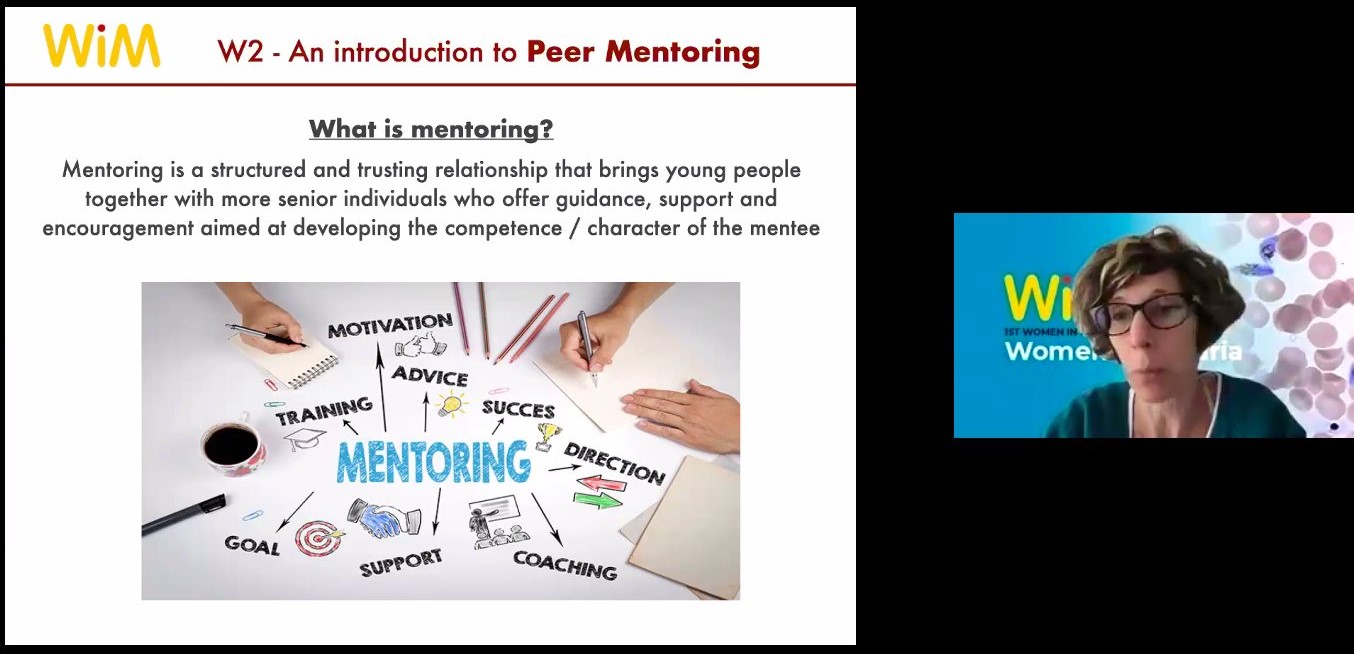
And a Round table discussion on “Increasing women’s leadership across all aspects of the malaria elimination fight – research, program implementation and policymaking” with Damaris Matoke-Muhia, Ghislaine Ouedraogo-Ametchie and Thu Do.

Session7 – Malaria functional genomics and epigenetics
The chairs for this session on “Malaria functional genomics and epigenetics”, Ana Rita Batista Gomes (University of Montpellier, France) and Joanne Power (Pennsylvania State University, USA), extended a warm welcome to the audience and introduced the speakers for this session.

Katarzyna Modrzynska (University of Glasgow, UK) talked about gene expression control during Plasmodium berghei transmission from host to vector, which is one of the most critical phases of the parasite life cycle. The team questioned how it is possible for an organism to have such a precise and tight regulation of cell cycle and yet depend on a repertoire of less than 30 AP2 transcription factors (TFs). To answer this question, her group tagged seven apiAP2 TFs for study during ookinete development. Two TFs were found to be present in asexual stages (AP2-O, AP2-OY), four were expressed in female gametocytes or zygotes, and four in ookinetes. Chromatin immunoprecipitation and sequencing (ChIP-seq) revealed the occurrence of these TFs in developing ookinetes. The shared binding preference of these TFs for certain DNA motifs suggested AP2-TF cooperation during ookinete development. They observed that AP2-O3/FG and AP2-O/O4 co-bind to many gene promoters, which suggests that these TFs can bind as heterodimers. Additionally, comparative ATAC-seq and TF ChIP-seq enabled examination of possible transcriptionally activating roles of TF pairs. The AP2-O ChIP-seq profile in asexual parasite stages differs from those shown during ookinete development. When looking at the CHIP-seq data of the homologous AP2-O in the human malaria parasite P. falciparum, the team found distinctive genome occupancy compared with another factor being also expressed at this cycle stage, AP2-I. Modrzynska ended her talk by suggesting that transcription factors may change their occupancy between Plasmodium life cycle stages to regulate different gene sets.
Anat Florentin (The Hebrew University of Jerusalem, Israel) discussed the mystery of the malaria plastid that ended up in the parasite as a result of endosymbiosis. The apicoplast is a unique organelle and has its own genome, though most apicoplast proteins are encoded by the nuclear genome. Florentin began by posing the question “How does an ancient endosymbiont maintain some autonomy?”. It turns out that in the absence of a mechanism within the apicoplast genome to regulate its own protein synthesis an apicoplast-localized caseinolytic protease (Clp) complex acts as a master regulator of apicoplast biogenesis through protein degradation. To understand this mechanism better, Florentin’s group studied the Clp system and the role it plays in organelle proteostasis in P. falciparum. The Clp protease subunit from Plasmodium falciparum (PfClpP) is required for apicoplast biogenesis and null mutant parasites were unable to survive. Conditional mutants using the TetR-DOZI system were generated and knockdown was confirmed in the absence of anhydrotetracycline (aTc) by western blot. However, this knockdown had no effect on parasite growth, indicating the presence of a post-translational regulation pathway. Florentin and colleagues then utilized CRISPR/Cas9 to express catalytically dead PfClpP and were able to demonstrate that PfClpP oligomerizes as a zymogen. They expressed wild-type and mutant Clp chaperone (PfClpC) variants that indicated a functional chaperone–protease interaction. Additionally, conditional mutants of the substrate-adaptor (PfClpS) indicated its essential function in plastid biogenesis. In conclusion, the apicoplast, although not able to synthesize its own proteins, regulates its protein content and maintains homeostasis by degrading proteins using the Clp system.
Megan Gliozzi (Food and Drug Administration, USA) began her talk by addressing the huge role that post-transcriptional regulation via RNA binding proteins (RBPs) plays in stage-specific gene regulation of Plasmodium parasites. This suggests that RBPs have the potential to be therapeutic targets. However, the RNA-protein interactome remains mostly unknown due to the absence of effective methodologies. Gliozzi then introduced a new and improved crosslinking method, photoactivatable ribonucleotide-enhanced crosslinking (PAR-CL) which offers higher sensitivity and specificity over conventional experimental methods to identify RBP proteins and their cognate RNA binding sites. This method depends on pyrimidine salvage and generates a signature mutation in RNA at crosslinking sites. They first generated P. falciparum mutants that exogenously express S. cerevisiae genes required for pyrimidine salvage. Following pre-incubation with 4-thiouracil (4TU) and photo-activated crosslinking to capture only proximal RBPs, the RNA-RBP complexes are purified and analysed via mass spectrometry and novel sequencing techniques. Their pilot proteomic studies have identified previously known Alba proteins among others, along with other unannotated RBPs. This study, therefore, establishes optimized conditions for PAR-CL in P. falciparum to study RNA-protein interactions throughout the parasite life cycle.
Michaela Petter (University Hospital Erlangen, Germany) and her laboratory are interested in chromatin regulation of the malaria parasite. Eukaryotic organisms demonstrate phenotypic plasticity and are capable of forming complex life forms. This is largely due to differential gene expression made possible by two chromatin states. Euchromatin (marked by H3K27 acetylation) is permissive of gene expression and heterochromatin (marked by H3K9 trimethylation) acts inversely. In this study, with the goal of studying sex-associated differences in chromatin-associated gene expression regulation in the malaria parasite, Petter and colleagues separated male and female P. falciparum gametocytes by FACS sorting of a P. falciparum transgenic line containing a female-specific ABCG2:GFP fusion protein. They then performed RNA-seq on days 1, 4 and 6 of gametocyte development, and performed ChiP-seq of various histone modification marks, to study the gametocyte epigenome, observing global remodelling of chromatin during sexual differentiation. Comparison of the heterochromatic H3K9me3 mark shows differential enrichment in male and female gametocytes. Euchromatic H3K27ac is enriched in strongly transcribed genes. These chromatin states act as codes for certain proteins such as bromodomain proteins, which bind to acetylated lysine residues at promoter sequences. This study suggests that P. falciparum bromodomain protein 1 (PfBDP1) is transcribed in both male and female gametocytes and localized to parasite nuclei. The group conditionally knocked down PfBDP1 with Shield-1 and showed abnormal parasite morphology during gametocytogenesis. Additionally, PfBDP1 was found to regulate IMC genes like GAP50, GAP45, and GAPM1, which showed lower expression when PfBDP1 was knocked down.
Karine Gaëlle Le Roch (University of California, USA) kicked off her keynote talk by reminding the audience that the first Plasmodium genome was published nearly 19 years ago and since then, a lot of genomic and transcriptomic data has been published. Nevertheless, we are still left puzzled by the gene regulation mechanism in the Plasmodium parasite. To decipher these mysteries, Le Roch’s lab is looking at additional transcriptional regulation mechanisms to fully understand the Plasmodium parasite’s complex life cycle. To identify molecular factors that determine chromatin structure, they decided to study the regulatory roles of long non-coding RNA (lncRNA) in P. falciparum. Extensive studies on lncRNA in other organisms have demonstrated their ability to carry out a myriad of functions including recruitment of transcription factors, chromatin-modifying complexes, and direct regulation of transcription and post-transcriptional pathways. Le Roch and her lab were able to demonstrate the localization and stage-specific expression of several lncRNAs in P. falciparum. To study the genome-wide occupancy of these lncRNAs, they carried out chromatin isolation by RNA isolation (with sequencing) (ChIRP-seq), which showed enrichment of genes involved in pathogenesis, erythrocyte remodelling, and regulation of sexual differentiation. They then focused on a particular lncRNA, lncRNA-14, that when was knocked out, resulted in parasites with a defective growth phenotype in gametocyte stages, indicating its involvement in sexual differentiation. All of these results suggest that in future, lncRNAs could be considered as therapeutic targets in combating malaria.
Session 8 – Epidemiology and modelling of malaria infections
The session chairs Fola Augusto (University of Kansas, USA) and Lauren Childs (Virginia Tech, USA) welcomed participants to the 8th session of the Women in Malaria Conference, which addressed epidemiology and modelling of malaria infections.
Hsiao-Han Chang (National Tsing Hua University, Taiwan) opened the session with a presentation about accounting for human mobility in malaria elimination settings using human travel and parasite genetic data. This is particularly applicable in settings where transmission is low and/or heterogeneous, as identifying sources and sinks of malaria parasites can help efficiently manage interventions and allocate resources. Chang and colleagues inferred parasite flow between populations in Chittagong, Bangladesh and estimated the proportions of imported cases using epidemiological and mobility data (travel surveys, and mobile phone calling data). Parasite genetic barcode data revealed 101 single nucleotide polymorphisms (SNPs) and identified genetic mixing, highlighting regions with high connectivity. These approaches showed high malaria incidence in eastern Chittagong and high importation in western Chittagong. Next, she parameterized a multi-patch model to observe incidence data. The model revealed significant heterogeneity in transmission intensity after incorporation of mobility data, and it was used to estimate the impact of interventions, such as vector control. Finally, Chang used both empirical and simulated genetic data to determine SNP numbers and sample sizes needed to reliably distinguish levels of gene flow between populations. She found that the ability to rank highly and less-highly connected population pairs improved with increased sample size and SNPs; however, the ability to rank with a small sample size was not substantially improved by using more SNPs. Taken together, Chang’s work provides insight into the effect of human movement on transmission, which is critical for malaria control and elimination.
Punam Amratia (University of Florida, USA) started the talk by giving details about a study performed on Hispaniola island, North America. This is the last Island with malaria transmission in the Caribbean region. There is a need to introduce effective malaria control tools, however, prior to this, there is a more urgent need to understand transmission dynamics such as where are the highest and most persistent risks. The study presented used monthly routine case information from 809 health facilities (2014-2017) and 771 (2018-2019). Emphasis was on 2 factors: (1) equitable access to health care and (2) appropriate denominator (catchment vs population) for incidence measurements from each facility. Model infrastructure was designed to provide an annual average of incidence and provide monthly outputs to identify what was the incidence. Yearly incidence models identified several trends, progressive declines over recent years, flow patterns, the origin of cases, and important covariates for transmission: e.g. accessibility, elevation, urban/barren etc. Amratia concluded that maps were proven to be operationally successful and could be used to target areas for spray rounds.
Gillian Stresman (London School of Hygiene and Tropical Medicine, UK) discussed the spatio-temporal transmission dynamics of a recent and contained Plasmodium falciparum (Pf) outbreak in Praia, Cabo Verde. This setting is unique, as reported incidence has been less than 1% since 2010, so it is likely that nearly all infections in this malaria-naive population would be symptomatic, enabling direct measurement of the reproduction number R0. To do this, 332 households of the 431 cases were retrospectively geolocated, and R0 was estimated using the joint likelihood of transmission between two cases based on date and proximity. Stresman found that the outbreak was likely seeded by an infection with an estimated R0 of 12. Through the epidemic, R0 ranged from 0 to 12, and the mean serial interval between care-seeking symptomatic cases was 31 days. The reproductive number declined as the outbreak progressed and was suppressed by indoor residual spraying. Stresman’s work is an interesting case study that provides insight into the transmission dynamics of P. falciparum and effective containment strategies in elimination settings.
Isabel Fletcher (London School of Hygiene and Tropical Medicine, UK) presented the link between high temperatures, rainfall and malaria transmission in Venezuela. She also explains that satellite imagery can clearly elaborate on land cover changes over time, and that deforestation is one of the most implicated causes for disturbing the environment. The aim of the study was to explore how the re-emergence of malaria in this country is amplified by environmental degradation, to what extent mining activities have contributed, and to identify the interaction between climatic factors and changing landscapes in determining malaria risk. A spatiotemporal Bayesian hierarchical modelling framework incorporating monthly case counts from 1996-2016 in Bolivar state, population estimates, spatial random effects, temporal random effects (allow accounting for seasonal peace and neighbourhood effects in different regions, random heterogeneity e.g. bednets), climate variables, deforestation and urbanization identified from satellite land cover map, mining sites, and healthcare accessibility was used. The results demonstrated that forest loss is one of the drivers of malaria and increased mining is also associated with increases in Pf and Pv malaria. Another contributor to transmission is the current the El Niño conditions, as well as poor healthcare access. However, urbanization showed trends toward reducing transmission. Fletcher concluded that mining and temperature, both higher in deforested areas where microclimatic changes have occurred, favoured the increase of malaria transmission and have driven re-emergence of the disease.
Nicole Mideo (University of Toronto, Canada) closed the session by presenting work on modeling drug resistance evolution in malaria parasites. She noted that parasite drug resistance generally arises rarely and in low-transmission settings. New resistance is unlikely to arise in high-transmission settings due to within-host competition and highly immune hosts, but interactions between immune-driven selection and drug resistance have rarely been investigated. To address this, Mideo presented a multiscale model tracking individual mosquitoes, hosts, and parasites. The model showed that immune selection in high-transmission settings enables sensitive parasites to remain in circulation, even when resistant parasites have an advantage. However, in low-transmission settings with weaker immune selection, resistant parasite strains can dominate without interference. These results demonstrate the evolutionary interplay between host immunity and drug resistance and may explain the counterintuitive origins of drug resistance.
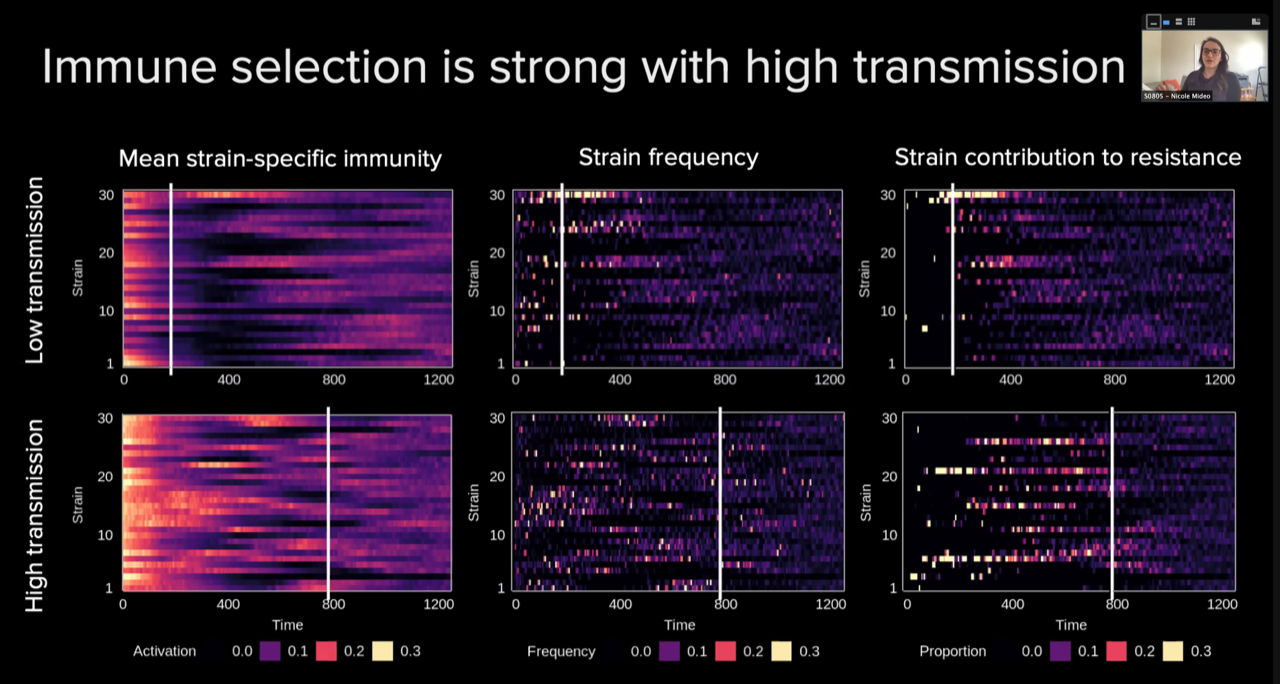
This report is brought to you by the MESA Correspondents Sushma Ambekar (Iowa State University, USA), Christine Markwalter (Duke Global Health Institute, USA), Rosheen Mthawanji (Malawi Liverpool Wellcome Trust, Malawi) and Nkahe Diane Leslie (University of Yaoundé I, Cameroon). Senior editorial support has been facilitated by Joanne Power (Pennsylvania State University, USA), Elena Gómez Díaz (Institute of Parasitology and Biomedicine López-Neyra, Spain) and Sarah Reece (The University of Edinburgh, UK).
Published: 22/03/2021
This report is brought to you by the MESA Correspondents Sushma Ambekar, Christine Markwalter, Rosheen Mthawanji, and Diane Leslie Nkahe. Senior editorial support has been facilitated by Joanne Power, Elena Gómez Díaz and Sarah Reece.
THEMES: Basic Science | Epidemiology | Health Systems
